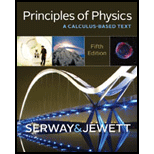
(a)
Whether the statement is true or not for an electron.
(a)
Answer to Problem 1OQ
True.
Explanation of Solution
In 1905 it was Einstein who suggested the concept of light having a wave particle duality. In a similar way Louise de Broglie suggested that electron also exhibits a dual nature.
Broglie derived a mathematical expression to prove the wave nature of electron along with the particle nature by the given expression,
Here,
Conclusion:
Therefore, the given statement is true for electron.
(b)
Whether the rest energy is zero.
(b)
Answer to Problem 1OQ
The statement is False.
Explanation of Solution
The expression for the rest mass energy is given by,
Here,
For the electron,
Conclusion:
Therefore, the rest mass energy of the electron will not be zero, the statement is False.
(c)
Whether it carries energy in its motion.
(c)
Answer to Problem 1OQ
The statement is true.
Explanation of Solution
Electrons in atoms can act as charge carriers. It carries energy in its motion. For a moving electron it will have a velocity along with the mass. For a moving particle it possess kinetic energy. Thus while moving electron also possess energy.
Conclusion:
Therefore, the statement is true.
(d)
Whether the electron carries momentum in its motion.
(d)
Answer to Problem 1OQ
The given statement is true.
Explanation of Solution
Write the expression for the momentum of a particle.
Here,
Electron possess a mass along with velocity in a motion. Thus electron will have momentum.
Conclusion:
Therefore, electron carries momentum in its motion so the given statement is true.
(e)
Whether the motion of the electron is described by a wave function that has a wavelength and satisfies a wave equation.
(e)
Answer to Problem 1OQ
The given statement is true.
Explanation of Solution
Electron exhibits both wave and particle nature. Its motion is described by a wave function that has a wavelength and satisfies a wave function. Equation (I) shows that electron have dual nature.
Conclusion:
Therefore, the given statement motion of the electron is described by a wave function that has a wavelength and satisfies a wave equation is true.
Want to see more full solutions like this?
Chapter 28 Solutions
Principles of Physics: A Calculus-Based Text
- (a) For a spherical capacitor with inner radius a and outer radius b, we have the following for the capacitance. ab C = k₂(b- a) 0.0695 m 0.145 m (8.99 × 10º N · m²/c²)( [0.145 m- 0.0695 m × 10-11 F = PF IIarrow_forwardA pendulum bob A (0.5 kg) is given an initialspeed of vA = 4 m/s when the chord ishorizontal. It then hits a stationary block B (1kg) which then slides to a maximum distanced before it stops. Determine the value of d.The coefficient of static friction between theblock and the plane is μk = 0.2. The coefficientof restitution between A and B is e = 0.8.Ans: d=1.0034 marrow_forwardFigure 29-43 Problem 12. ••13 In Fig. 29-44, point P₁ is at distance R = 13.1 cm on the perpendicular bisector of a straight wire of length L = 18.0 cm carrying current i = 58.2 mA. (Note that the wire is not long.) What is the magnitude of the magnetic field at P₁ due to i? P2° R R Larrow_forward
- Checkpoint 1 The figure shows the current i in a single-loop circuit with a battery B and a resistance R (and wires of neg- ligible resistance). (a) Should the emf arrow at B be drawn pointing leftward or rightward? At points a, B C R b, and c, rank (b) the magnitude of the current, (c) the electric potential, and (d) the electric potential energy of the charge carriers, greatest first.arrow_forwardPls help ASAParrow_forwardPls help asaparrow_forward
- Pls help asaparrow_forward3. If the force of gravity stopped acting on the planets in our solar system, what would happen? a) They would spiral slowly towards the sun. b) They would continue in straight lines tangent to their orbits. c) They would continue to orbit the sun. d) They would fly straight away from the sun. e) They would spiral slowly away from the sun. 4. 1 The free-body diagram of a wagon being pulled along a horizontal surface is best represented by A F N B C 0 Ꭰ FN E a) A b) B c) C app app The app 10 app d) e) ס ח D E 10 apparrow_forwardPls help ASAParrow_forward
 Principles of Physics: A Calculus-Based TextPhysicsISBN:9781133104261Author:Raymond A. Serway, John W. JewettPublisher:Cengage Learning
Principles of Physics: A Calculus-Based TextPhysicsISBN:9781133104261Author:Raymond A. Serway, John W. JewettPublisher:Cengage Learning University Physics Volume 3PhysicsISBN:9781938168185Author:William Moebs, Jeff SannyPublisher:OpenStax
University Physics Volume 3PhysicsISBN:9781938168185Author:William Moebs, Jeff SannyPublisher:OpenStax Modern PhysicsPhysicsISBN:9781111794378Author:Raymond A. Serway, Clement J. Moses, Curt A. MoyerPublisher:Cengage Learning
Modern PhysicsPhysicsISBN:9781111794378Author:Raymond A. Serway, Clement J. Moses, Curt A. MoyerPublisher:Cengage Learning Physics for Scientists and Engineers with Modern ...PhysicsISBN:9781337553292Author:Raymond A. Serway, John W. JewettPublisher:Cengage Learning
Physics for Scientists and Engineers with Modern ...PhysicsISBN:9781337553292Author:Raymond A. Serway, John W. JewettPublisher:Cengage Learning Physics for Scientists and Engineers: Foundations...PhysicsISBN:9781133939146Author:Katz, Debora M.Publisher:Cengage Learning
Physics for Scientists and Engineers: Foundations...PhysicsISBN:9781133939146Author:Katz, Debora M.Publisher:Cengage Learning




